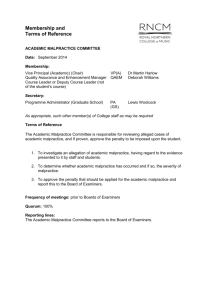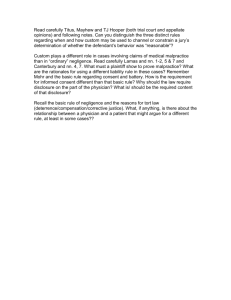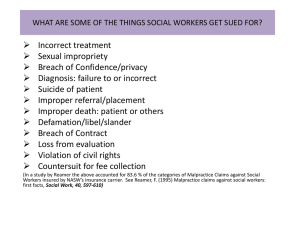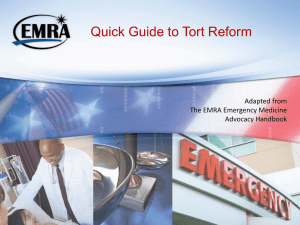Physicians and Tort Reform By Laura Hermer, J.D., L.L.M.
advertisement
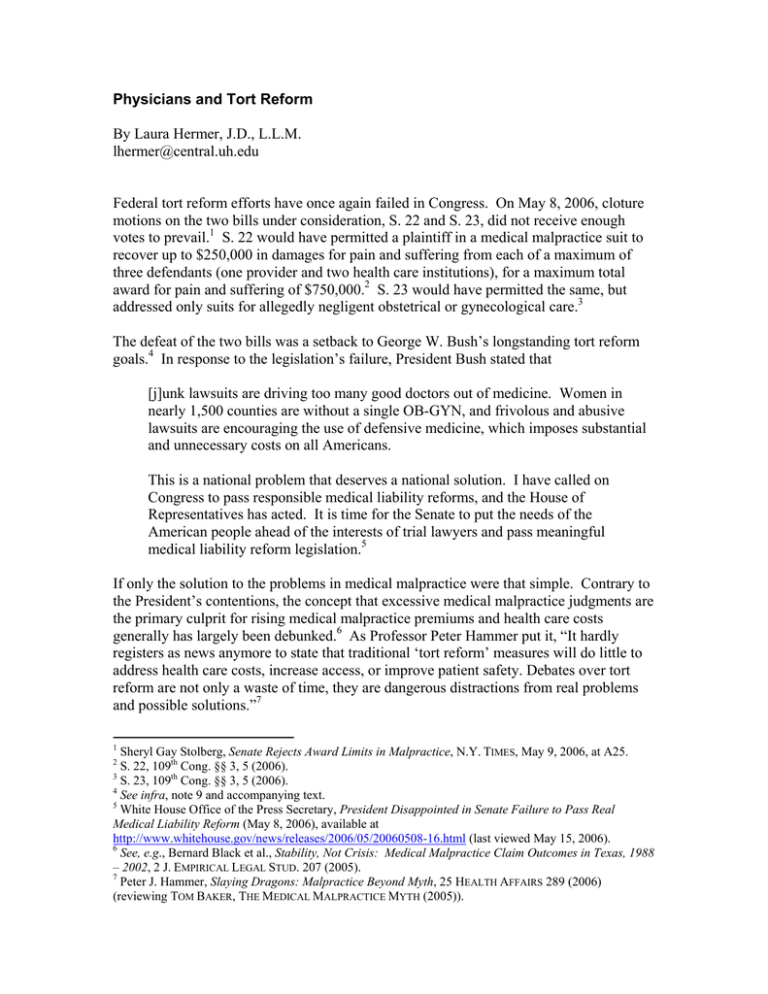
Physicians and Tort Reform By Laura Hermer, J.D., L.L.M. lhermer@central.uh.edu Federal tort reform efforts have once again failed in Congress. On May 8, 2006, cloture motions on the two bills under consideration, S. 22 and S. 23, did not receive enough votes to prevail.1 S. 22 would have permitted a plaintiff in a medical malpractice suit to recover up to $250,000 in damages for pain and suffering from each of a maximum of three defendants (one provider and two health care institutions), for a maximum total award for pain and suffering of $750,000.2 S. 23 would have permitted the same, but addressed only suits for allegedly negligent obstetrical or gynecological care.3 The defeat of the two bills was a setback to George W. Bush’s longstanding tort reform goals.4 In response to the legislation’s failure, President Bush stated that [j]unk lawsuits are driving too many good doctors out of medicine. Women in nearly 1,500 counties are without a single OB-GYN, and frivolous and abusive lawsuits are encouraging the use of defensive medicine, which imposes substantial and unnecessary costs on all Americans. This is a national problem that deserves a national solution. I have called on Congress to pass responsible medical liability reforms, and the House of Representatives has acted. It is time for the Senate to put the needs of the American people ahead of the interests of trial lawyers and pass meaningful medical liability reform legislation.5 If only the solution to the problems in medical malpractice were that simple. Contrary to the President’s contentions, the concept that excessive medical malpractice judgments are the primary culprit for rising medical malpractice premiums and health care costs generally has largely been debunked.6 As Professor Peter Hammer put it, “It hardly registers as news anymore to state that traditional ‘tort reform’ measures will do little to address health care costs, increase access, or improve patient safety. Debates over tort reform are not only a waste of time, they are dangerous distractions from real problems and possible solutions.”7 1 Sheryl Gay Stolberg, Senate Rejects Award Limits in Malpractice, N.Y. TIMES, May 9, 2006, at A25. S. 22, 109th Cong. §§ 3, 5 (2006). 3 S. 23, 109th Cong. §§ 3, 5 (2006). 4 See infra, note 9 and accompanying text. 5 White House Office of the Press Secretary, President Disappointed in Senate Failure to Pass Real Medical Liability Reform (May 8, 2006), available at http://www.whitehouse.gov/news/releases/2006/05/20060508-16.html (last viewed May 15, 2006). 6 See, e.g., Bernard Black et al., Stability, Not Crisis: Medical Malpractice Claim Outcomes in Texas, 1988 – 2002, 2 J. EMPIRICAL LEGAL STUD. 207 (2005). 7 Peter J. Hammer, Slaying Dragons: Malpractice Beyond Myth, 25 HEALTH AFFAIRS 289 (2006) (reviewing TOM BAKER, THE MEDICAL MALPRACTICE MYTH (2005)). 2 Public policy theory can help explain why some legislators and other politicians continue to subscribe to the current tort reform paradigm.8 For example, we can see that rising medical malpractice premiums have been identified by some members of Congress, the Administration, and the public, as a problem. Depending on the data that one chooses to examine (or, alternatively, to ignore), tort reform as a policy proposal can, with at least superficial plausibility, be couched as a reasonable solution for rising malpractice premiums and, in the context of those premiums and of defensive medicine, rising health care costs. However, if one frames the issue of rising malpractice premiums not as a matter of frivolous, runaway medical malpractice cases and exorbitant judgments but rather as, for example, inadequate regulation of investments and rate increases by medical malpractice insurance carriers and poor performance in the general financial markets, among other matters, then one might come up with a very different solution to the problem. Yet tort reform, rather than, say, more robust insurance regulation, has been one of the administration’s and certain key legislators’ goals since the early years of the current president’s first administration.9 It is therefore not surprising to see it being proposed in Washington now. However, it is more difficult to see why various physicians’ continue doggedly to support the sort of tort reform offered by S. 22 and S. 23.10 On the face of it, it might seem that making medical malpractice suits less potentially costly and less attractive for attorneys to file by limiting awards for pain and suffering and curtailing attorney’s fees is clearly in physicians’ best interests. While the evidence is mixed, some credible studies do show that malpractice premiums are generally lower in states that have enacted damage caps.11 But the view that caps and fee limitations are the solution to present malpractice woes is likely short-sighted, at best. First, it does nothing to address the serious problems of medical negligence and errors. For better or worse, a primary purpose of the medical malpractice system is to help prevent medical errors and compensate patients for them when they occur. If we restrict malpractice suits, the need to reduce medical error will still remain. Second, it also does nothing to address the shame, humiliation and secondguessing of medical judgment that malpractice suits bring to physicians, whether or not 8 One widely-cited theory developed by John Kingdon observes that significant public policy changes tend to be made when three “streams” converge: those of problem recognition, policy proposals, and political settings. John W. Kingdon, The Reality of Public Policy Making, in ETHICAL DIMENSIONS OF HEALTH POLICY 100 – 01, (Marion Danis et al., eds., 2002). One’s recognition of a problem or belief that one exists is not necessarily a purely objective matter, but rather an issue of how one frames available data. Id. at 100. This, in turn, is further influenced by the policy proposals one wishes to advance and the political milieu in which one must work. Id. at 102 - 03. When one has a receptive legislature and can convince enough of the public that one’s policy proposal offers a good solution to the perceived problem, then the proposal’s chance of success can be high. 9 See, e.g., White House Office of the Press Secretary, Press Briefing by Ari Fleischer (Feb. 6, 2001), available at http://www.whitehouse.gov/news/briefings/20010206.html (last viewed May 15, 2006). 10 See, e.g., http://www.ama-assn.org/ama/pub/category/6087.html and related links. 11 See, e.g., Kenneth E. Thorpe, The Medical Malpractice ‘Crisis’: Recent Trends and the Impact of State Tort Reforms, HEALTH AFFAIRS WEB EXCLUSIVE (Jan. 21, 2004), http://content.healthaffairs.org/cgi/reprint/hlthaff.w4.20v1?maxtoshow=&HITS=10&hits=10&RESULTFO RMAT=&author1=thorpe&fulltext=medical+malpractice&andorexactfulltext=and&searchid=1&FIRSTIN DEX=0&resourcetype=HWCIT. any actual negligence occurred.12 Tort reform of the sort provided in S. 22 and S. 23 would neither do anything to reduce the shame and aggravation of suits, nor would it help implement a saner system that would both fairly compensate those who are injured by medical error and encourage the sort of reevaluation necessary to help better avoid such errors in the first place.13 Damage caps and attorney’s fees limits will not make medical malpractice suits, with their concordant aggravation, stress and embarrassment for health care providers, vanish. They will not more fairly compensate a greater number of patients who genuinely are injured by medical error. And they will not facilitate the creation of effective and efficient systems to reduce medical error and negligence. If anything, they merely forestall the development of a system that functions better for everyone involved. Tort reform does not require a choice between caps and fee limits, on the one hand, and an unrestricted liability regime, on the other. As physicians should know from painful experience over the past several decades, attempting to prevent eventual systemic change within the health care system, rather than helping to lead such change, can leave health care practitioners with significantly diminished influence within any new regime that might be created.14 Physicians’ groups should accordingly reconsider their position on the issue of tort reform. June 2006 12 See, e.g., Maxwell Mehlman, The Shame of Medical Malpractice, 27 J. LEGAL MED. 17, 24 - 27 (2006) Thorpe, Mehlman, Baker and many others discuss this issue. See, e.g., Thorpe, supra note 11; Mehlman, supra note 12; BAKER, supra note 7. 14 Witness, for example, radical changes in the financing of health care over the past forty years and their effect on physicians and the practice of medicine. For more information, see generally PAUL STARR, THE SOCIAL TRANSFORMATION OF AMERICAN MEDICINE (1982). 13

